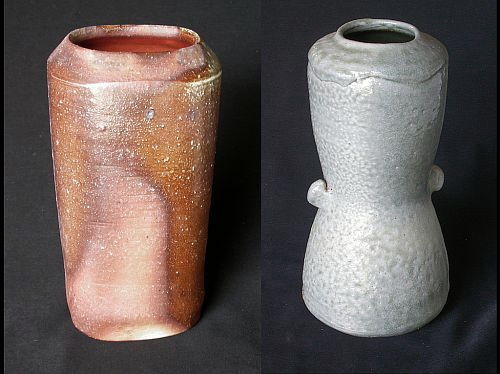|
|
Controlled Reduced Cooling 3 |
 |
This is the firing
schedule used to refire the anagama pot shown in
images on the previous page. From trial and error, over more than 30
test firings, I had decided that
this schedule gave the best results, on the whole, for refiring salt or
shino pots. The four hour cooling period, in oxidation,
between
900 and 800 originated in "extended bisque" firings, in which
I
refired shino glazed pots, to good effect. The reducing agent
used during cooling was the moist, fleshy leaves and stems of
decorative ginger plants, Hedychium
coronarium, which is native to the Himalayas.
|
| Remember that the
refired pot,
the one the cones leaned against, was produced
during the
period when we were trying to decide which woods we wanted to use. We
settled on two readily available woods, and removed the dividing wall
from the kiln. The images at right show the most undesirable results
from the two wood types. The brown of the pot on the left originates
from Forest Red Gum, and the unrelieved grey of the pot on the right is
due to the wrong thickness of Blackwood (Acacia melanoxylon)
natural
ash glaze. Before applying the firing schedule from the small
gas
refire kiln to the cooling of the anagama we wanted to try to predict
what would happen. We wanted both of these undesirable effects to be
diminished. |
 |
 |
Usually
we like to evaluate pots by looking at the pots, not by applying some
extraneous rule, or any rule at all. Direct perception,
without further thought, is an impossible goal, but the
phrase
expresses our preferred, non-intellectual approach. Our sources of
enthusiasm are almost always ceramic, and not related to our
surroundings, but the influence of our unusual landscape must be
acknowledged. We live in tropical rainforest, and one of the hillsides
on our property is shown at left. Notice the amount of black
in
this scene, where rainforest trees fight to reach the light. Couple
this landscape with my enduring enthusiasm for photography,
which
goes back as far as the black and white landscapes of Ansel Adams, and
the desire to encourage black on the pots is explicable.
|